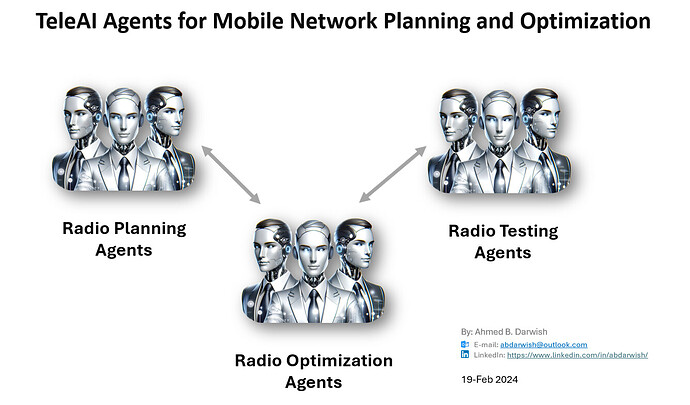Executive Summary:
This white paper presents a groundbreaking approach to mobile radio network planning, optimization, and testing, inspired by Multi AI Agents frameworks developed for building powerful applications with LLMs, I have adapted and extended this concept to address the unique challenges of mobile network planning and optimization. Our adaptation of multi-ai agents utilizes advanced artificial intelligence (AI) to automate critical processes, offering unprecedented improvements in efficiency, accuracy, and cost-effectiveness.
Introduction
The advent of 5G and the anticipation of 6G technologies have ushered in a new age of complexity in mobile radio network management. The integration of IoT devices, the need for ultra-reliable low-latency communications, and the ever-increasing consumer demand for bandwidth pose significant challenges. TeleAI Agents leverages AI to automate the planning, optimization, and testing phases, significantly improving the efficiency, accuracy, and cost-effectiveness of mobile network deployment and management.
Background
Mobile networks are evolving rapidly, with each generation introducing new challenges in planning and optimization. The complexity of modern networks, coupled with the sheer volume of data traffic and the diverse needs of applications, makes traditional network planning methods inadequate. This section explores the limitations of current practices and the necessity for innovative solutions like TeleAI Agents.
The TeleAI Agents Solution
Overview
At its core, TeleAI is a suite of AI-driven agents, each specializing in distinct aspects of network planning, optimization, and testing. By automating these critical processes, TeleAI not only accelerate network deployment but also ensure optimal performance and reliability.
Planning Agent
Roles and Responsibilities
The Planning Agent is tasked with designing the network infrastructure. This involves analyzing geographical data, projecting user demand, and selecting the appropriate equipment to meet coverage and capacity requirements.
Tasks
Utilization of AI algorithms to process vast amounts of geographical and demographic data, identifying optimal locations for cell sites.
Simulation models to predict user demand and select network elements that match capacity needs while minimizing costs.
Optimization Agent
Roles and Responsibilities
This agent focuses on enhancing network performance post-deployment. It adjusts network parameters in real-time, based on continuous monitoring of network KPIs and user experience metrics.
Tasks
Implement AI-driven predictive models to identify potential performance bottlenecks before they affect users.
Automate network parameter adjustments to optimize data throughput, reduce latency, and improve overall service quality.
Testing Agent
Roles and Responsibilities
The Testing Agent ensures the network meets its design specifications and performance standards through rigorous, ongoing testing protocols.
Tasks
Automated field testing to validate network coverage and performance, utilizing drones and mobile units.
Detailed reporting of issues and optimization opportunities, enabling proactive maintenance and improvements.
Benefits of TeleAI:
TeleAI Agents revolutionizes network planning and management by offering:
Accuracy: AI algorithms analyze data with precision, reducing errors in network design and optimization.
Efficiency: Automation speeds up planning and testing processes, enabling faster network deployment and iterative improvements.
Cost-Effectiveness: By optimizing resource allocation and reducing the need for manual intervention, TeleAI significantly lowers operational costs.
Case Studies
This section presents real-world applications of TeleAI, showcasing its effectiveness in diverse scenarios, from urban to rural network deployments. Each case study highlights the challenges faced, the solutions implemented by TeleAI, and the outcomes in terms of performance improvements and cost savings.
Future Directions
The future of TeleAI includes the integration of next-generation AI algorithms for even more sophisticated predictive analytics, and its application in the planning and optimization of 6G networks. This section explores potential advancements and the impact they could have on the telecommunications industry.
Conclusion
TeleAI represents a paradigm shift in mobile radio network planning, optimization, and testing. By harnessing the power of AI, it offers unprecedented levels of efficiency, accuracy, and reliability, making it an indispensable tool for network operators facing the challenges of today and tomorrow.
By:
Ahmed B. Darwish
LinkedIn: Ahmed Bahaaeldin Darwish on LinkedIn: #innovating #teleai_agents #llm #innovation #breakthrough…
